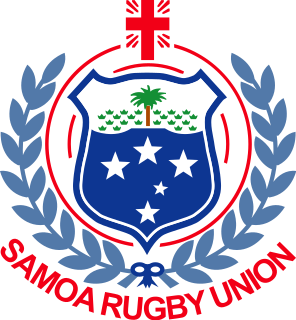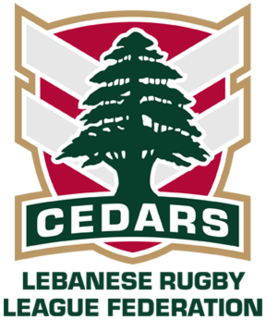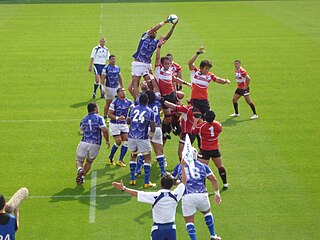
The Bledisloe Cup is a rugby union competition between the national teams of Australia and New Zealand that has been contested since the 1930s. The frequency at which the competition is held has varied, as has the number of matches played, but it currently consists of an annual three-match series, reduced to a two-match series in World Cup years, with two of the matches also counting towards The Rugby Championship. New Zealand have had the most success, winning the trophy in 2020 for the 48th time, while Australia have won the trophy 12 times.
The 1999 Rugby World Cup was the fourth Rugby World Cup, the quadrennial international rugby union championship. It was principally hosted by Wales, and was won by Australia. This was the first Rugby World Cup to be held in the sport's professional era.

The Georgia national rugby union team, nicknamed The Lelos, represents Georgia in men's international rugby union. The team is administered by the Georgian Rugby Union and takes part in the annual Rugby Europe Championship and the Rugby World Cup, which takes place every four years.

The Australia national rugby union team, nicknamed the Wallabies, is the representative national team in the sport of rugby union for the nation of Australia. The team first played at Sydney in 1899, winning their first test match against the touring British Isles team.

The France national rugby league team represent France in international rugby league matches. They are referred to as les Chanticleers or less commonly as les Tricolores. The team is run under the auspices of the Fédération Française de Rugby à XIII.

The Samoa national rugby union team represents Samoa in men's international rugby union and it is governed by the Samoa Rugby Union. The name Manu Samoa is in honour of a famous Samoan warrior. They perform a traditional Samoan challenge called the siva tau before each game. Samoa Rugby Union were formerly members of the Pacific Islands Rugby Alliance (PIRA) along with Fiji and Tonga. They are ranked 15th in the world.

The Fiji national rugby union team represents Fiji in men's international rugby union competes every four years at the Rugby World Cup, and their best performances were the 1987 and 2007 tournaments when they defeated Argentina and Wales respectively to reach the quarterfinals. Fiji also regularly plays test matches during the June and November test windows. Fiji also plays in the Pacific Tri-Nations, and has won the most Pacific Tri-Nations Championships of the three participating teams.
The United States men's national rugby union team, represents United States of America in men's international rugby union, nicknamed the Eagles it is controlled by USA Rugby. USA Rugby is a member of Rugby Americas North, one of six regional governing bodies under World Rugby. Until rugby returned to Olympic competition, with sevens at the 2016 Rio Games, the United States was the reigning Olympic rugby champion, having defeated the one other competitor in 1920 and the two other competitors at the 1924 Summer Olympics.

The Tonga national rugby league team represents Tonga in rugby league football. They are currently the fourth ranked team in the world. The team was formed to compete in the 1986 Pacific Cup, and have competed at five Rugby League World Cups, starting in 1995 and continuing consecutively until the most recent tournament in 2017, where they achieved their best ever result as semi-finalists.
The Fiji national rugby league team, nicknamed the Bati, has been participating in international rugby league football since 1992. The team is controlled by the governing body for rugby league in Fiji, Fiji National Rugby League (FNRL), which is currently a member of the Asia-Pacific Rugby League Confederation (APRLC). Fiji have thrice reached the semi-finals of the Rugby League World Cup, in 2008, 2013 and 2017, and are currently ranked 5th in the Rugby League International Federation's World Rankings.

The Lebanon national rugby league team is the representative side of Lebanon in rugby league football. It is the top tier team of the Lebanese Rugby League Federation. They are nicknamed "The Cedars" after the Lebanon Cedar tree, which is also on the Lebanese flag. The team has been participating in international competition since 1998. The team was originally formed in New South Wales, Australia, composed of Lebanese Australians. But their success has helped the game grow in Lebanon and now players are also taken from the newly formed Lebanon Championship as well as the National Rugby League in Australia.

The Pacific Nations Cup is an international rugby union competition held between three Pacific nations: Fiji, Samoa and Tonga. The 2019 edition of the tournament will also include the national teams of Canada, Japan and United States. First held in 2006, the tournament is intended to strengthen the Tier 2 rugby nations by providing competitive test matches in a tournament format.
Rugby World Cup records have been accumulating since the first Rugby World Cup tournament was held in 1987.
The Cook Cup is a rugby union trophy contested between Australia and England. The cup was established in 1997 when the Wallabies and England contracted to play each other bi-annually for a decade, playing matches on a home and away basis. Since the first two years the format has only been adhered to once. In most years, there is only one match and World Cup matches are not counted. The cup is named after Captain James Cook, representing a strong English–Australian connection. The cup, which was designed by Royal Doulton in London, is made from crystal.

Rugby union in Fiji is a popular team sport and is considered to be the national sport of the country. The sport was introduced to Fiji in the 1880s. Fiji is defined as a tier two rugby nation by World Rugby. The national team has competed at the Rugby World Cup and made it as far as the quarter finals. Their sevens team is also noted for their success, and have won the Rugby World Cup Sevens twice and the World Rugby Sevens Series three times.
The rivalry between the England and Australia national rugby union teams started on 9 January 1909 at Blackheath's Rectory Field in England, during the 1908-09 Australia rugby union tour of Britain, dubbed the 1st Wallabies. The Wallabies won the match 9–3. The two nations next met in 1928, at Twickenham, during the 1927-28 Waratahs tour of the British Isles, France and Canada and England won 18–11. After the 1939-40 Australia rugby union tour of Britain and Ireland was cancelled due to the outbreak of World War II, twenty years passed before England and Australia next met, again at Twickenham, with Australia winning the 1948 test 11–0. It would then be another decade until the two nations played another test against one another. In 1958, they met again at Twickenham, and England won 9–6.
The Rugby League Four Nations, is a biennial rugby league football tournament run in partnership between the Australian Rugby League Commission, Rugby Football League and New Zealand Rugby League representing the top three nations in the sport: Australia, England and New Zealand. The tournament replaced the previous Tri-Nations format by including a fourth nation that qualifies by winning their respective regional competition in a rotation between Europe and the South Pacific. France accepted an invitation to play in the inaugural tournament in 2009. No tournament was contested in 2012 to allow teams to prepare for the 2013 Rugby League World Cup. No tournament has been played since 2016.

The contest between The Wallabies and The Springboks is one of the major rivalries in rugby union.
For the most recent Mid-year window go to 2018 June rugby union tests
The Samoa national rugby union team and the Fiji national rugby union team have played each other on 53 occasions, with Fiji winning the most at 30 wins to Samoa's 20.










